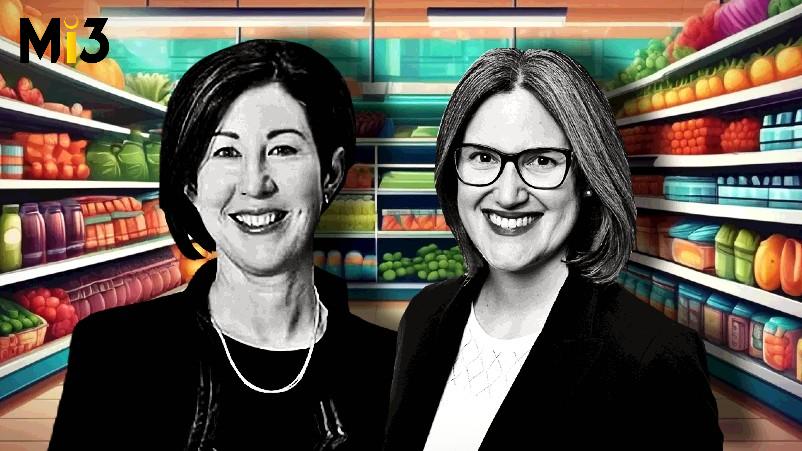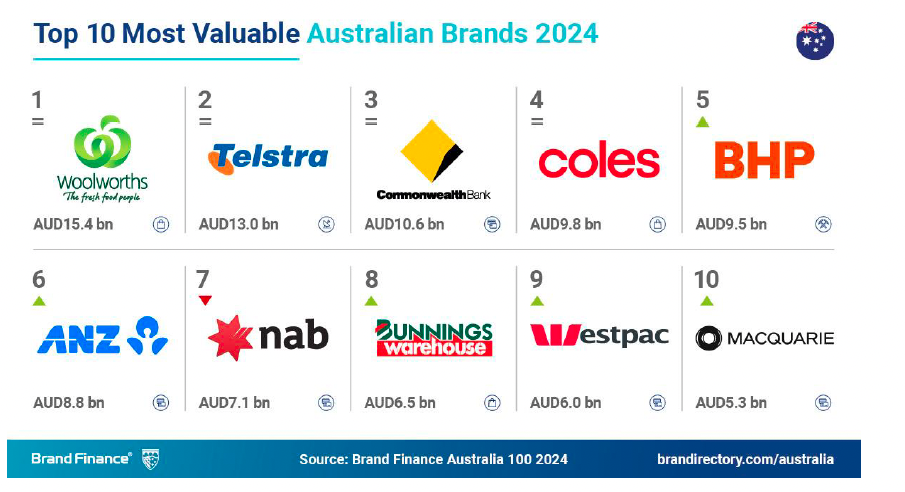Ecom roars back to life as Coles and Woolies power; Banducci bows out with a wrap for retail media unit Cartology but Coles 360 growth rate outstrips rival

What you need to know:
- Ecommerce sales at Australia’s two giant grocers are enjoying rude health, a reversal of the grim tidings of just 18 months ago when keyboard shoppers went on a post-pandemic strike (while still heading into their stores).
- Coles Supermarkets and WooliesX both had very strong revenue growth.
- But none of this happens in isolation. Instead it’s the result of years’ worth of investment in digital experiences, scaling up retail media, extending loyalty programs, fixing and enhancing fulfilment, and reinvigorating core technology infrastructure.
- And both companies have called out the possibilities of AI to drive future productivity improvements, better customer experiences, and ultimately stronger growth for the business
- Customers, however, are feeling the pinch – and that’s reflected in net promoter scores (NPS). For Woolies Q4 NPS was down a point compared to the same quarter last year, and now sits at 47 – but even here there was good news. It’s been growing against the previous quarters. Coles online NPS was up slightly to 22.1. It didn’t disclose total NPS in the investor packs
Strong sales growth, higher pickup mix, and productivity programs across fulfilment operations and last mile deliveries led to material improvement in profitability with ecom X normalised GAAP up 119 per cent.
For years grocery was considered the laggard of the Australian ecommerce sector. Not any more. Both Coles and Woolworths recorded surging ecommerce sales over the last year, flipping the steep reverses that followed the pandemic boom.
At a headline level, Coles’ ecom revenue grew to $3.295bn from $3.03bn. Woolworths grew to just under $8bn, up from just shy of $6.6bn the prior year.
Drilling a little deeper, ecommerce for Coles supermarkets grew a stunning 30.1 per cent while Woolworths’ WooliesX climbed 20.2 per cent.
It’s a long way from the grim outcomes of early 2023 when the firms were reporting “dramatic” ecommerce drops, and Woolworths CEO Brad Banducci was complaining about how painful it was to bring new customer fulfilment centres online.
It’s all feeding into the bottom lines, which were mixed. Coles recorded net profit after tax of $1.128bn (up 2.1 per cent) for the financial year, while Woolworths reported a small decline in NPAT to $1.711bn, a reversal of 0.6 per cent.
Timing is everything
18 months later and that must now all seem like a bad dream.
According to Coles CEO Leah Weckert who replaced retiring chief Stephen Cain last year, “We have delivered strong ecommerce sales growth by expanding the offer and improving customer experience. We have also managed our cost base … in addition to tackling and driving improvements in availability.”
Speaking to investors after the results were announced, Weckert said, “Another significant highlight is the key milestones we have reached on our ADC and CFC projects.” (These are respectively the big automated distribution centres and customer fulfilment centres Coles is building with Ocado, which suffered some delays but should enable a significant increase in SKUs alongside efficiency gains.)
“I’m pleased to say that operations at all four facilities have now commenced. We had the official opening of the Kemps Creek ADC earlier this month, the Redbank ADC ramp-up is complete, and at both of our CSCs, we commenced operations in July during the year.”
Woolworth’s ecommerce also ran red hot.
According to incoming CEO Amanda Bardwell, “Ecom sales were a little under $8 billion, with normalised growth of 18.5 per cent, led by WooliesX ecommerce sales growth of 20.2 per cent, which remained strong throughout the year.”
In the Woolworths investor call she told analysts, “Including Milk Run (Which Woolworth bought in May last year) Australian food ecom sales increased by 21.3 per cent for F24.”
Per Bardwell, “Strong sales growth, higher pickup mix, and productivity programs across fulfilment operations and last mile deliveries led to material improvement in profitability with ecom X normalised GAAP up 119 per cent.”
Distribution and fulfilment improvement are big contributors to the success of the firm’s ecommerce operation. “Ecom growth is being supported by the expansion of our convenience proposition, with 86 per cent of our B2C ecom orders now fulfilled within 24 hours, an increase of six points compared to the prior year.”
It’s also noteworthy that during the last year, Woolworths launched a new sub-60-minute collection service, which it calls Direct-to-Boot Now, at 307 sites. “That is in addition to our 727 Direct-to-Boot sites across the country,” said Bardwell. “We also established Home Run as the group’s last mile delivery service provider, with 20 million orders delivered since launch.”
In both cases it’s a reminder that the profit performance of Australia’s two biggest grocers reflects the power of integration between core areas of investment over the last decade to meet increasing demand for faster deliveries of a broader range of goods.
The flywheel seems to be spinning faster: Ecommerce needs strong distribution to deliver to customer expectations. Data from loyalty programs like Flybuys and Everyday Rewards fuels powerful retail media activations across Coles360 and Cartology, and all of it is built upon a sophisticated technology infrastructure that provides an increasingly seamless experience for the customer at the checkout or online.
Mi3 analysed this week’s earnings calls and investor packs from Coles and Woolworth to draw out some of the key details.
Coles 360 has continued to deliver strong results during the year, with media income increasing by 20.5% on a normalized basis, with strong advertiser demand growth across our digital offerings, including offerings in store and through Coles
online
Coles
Coles Group Limited has reported a robust performance from its retail media division with Coles 360’s media income experiencing strong growth. According to Weckert, “Coles 360 has continued to deliver strong results during the year, with media income increasing by 20.5 per cent on a normalised basis, with strong advertiser demand growth across our digital offerings, including offerings in store and through Coles online.”
The retail media unit earlier this year launched measurement platform Coles 360 Impact, designed to prove to advertisers that their money is driving incremental sales and led by ex-Meta marketing science boss Andy Ford.
Marketers from Nestle, Pepsico, Baiada and Jacobs Douwe Egberts were among a slew of supermarket suppliers who proffered conditional support in Mi3’s 2023 Retail Media Report for the charge by the supermarkets to expand their media and advertising units. Cracking measurement and attribution, they said, was key to unlocking budgets beyond standard trade spend.
Moreover, the company has expanded its media operation into the liquor segment while bolstering its screen network to north of 600 as of June 2024.
As eCommerce penetration continues to grow—reaching 9.4 per cent for supermarkets and 6.2 per cent for liquor sales—Coles 360’s role in driving online traffic and sales is increasingly important. As is its profit contribution with retail media margins far higher than the cut made for selling hard goods.
The new fulfilment centres will also feed the retail media business – because it means Coles 360 has a larger range of stock-keeping units, or SKUs, to advertise.
More broadly with the NSW and Victorian CFCs now up and running, Coles is also confident that Metropolitan Sydney and Melbourne next-day home delivery orders will be transitioned by the end of December. Looking ahead the CFCs should start to drag less on the company’s bottom line. According to its investor pack, FY25 implementation and transition costs are expected to be ~$70 million, a figure that is lower than initially expected largely due to the earlier opening of Truganina CFC in Melbourne, and accelerated transition plans.
On the tech front, the company has an increasingly mature cloud infrastructure and says it has delivered a new cloud data platform which means 90 per cent of data is now available in its Cloud Data Domains. Coles is also looking to improve demand forecasting and automated ordering in its liquor division, following the rollout of a project – ‘Liquor Easy Ordering’ – that presumably does what it says on the tinny.
It is also investing in artificial intelligence. This year it says it partnered with “a leading global AI provider” to drive operational improvements, including further optimising rostering and enabling more team members to receive their desired hours.
While not named in the pack, the partner is believed to be Microsoft: In a statement earlier this year, Microsoft said it was working with Coles to pioneer the use of AI technology starting with an ambition to transform operations, which it said has now matured into an impressive suite of AI models that drive the day-to-day engine of its sprawling operations.
According to Microsoft, “This AI-backed operational efficiency helps Coles predict the flow of 20,000 stock-keeping units (SKUs) to 850 stores nationwide with astonishing accuracy, harnessing insights from over 2,000 diverse data sets to make 1.6 billion predictions each day. Much more than mere numbers, these are the heartbeats of a system ensuring that every Coles customer finds exactly what they’re looking for, exactly when they need it.”
Coles is also believed to be using AI to personalise shopping experiences.
According to Microsoft, “Over four million FlyBuys customers receive bespoke weekly product recommendations curated by an AI model that understands their preferences in the context of broader customer patterns.”
The AI focus is now said to be moving from beyond project initiation to scaling solutions across the enterprise. If Microsoft lives up to its own hype, expect profits to climb for both parties.
Woolworths reserves 50 per cent of Cartology's inventory for the group, with the remaining 50 per cent monetised through generally endemic, but increasingly, non-endemic advertisers. So the value to the group is just as important as the value monetised really through our clients.
Woolworths
Hosting his final earnings call before pulling up stumps in September, outgoing CEO Brad Banducci highlighted the growth of Cartology, which has flourished during its first half-decade, averaging compound annual growth (CAGR) of 34 per cent since its launch in 2019.
For Banducci, who has held the job for a decade, Cartology is one of the great success stories of his tenure. 2024 revenue growth was for the first time single digit at 9 per cent, which he acknowledged was relatively low by previous standards. But any other local media owner would give their eye teeth for that kind of result in the year just gone.
Meanwhile, “We delivered over 5,000 campaigns while also providing very importantly, valuable media inventory for the group,” Banducci added.
“On the media inventory inside Cartology, we reserve 50 per cent for the group, and 50 per cent is then monetised through generally endemic, but increasingly also in some instances, non endemic advertisers. And so the value for the group is as important as the value monetised through our clients.”
He said that Woolworths had added 400 health and beauty screens across its supermarkets, while partnerships will added “around 1,000 screens in over 50 shopping centres, and that is in the process of being rolled out.”
Digital revenues
Banducci underlined that Cartology’s digital revenues “are an increasing contributor to growth … and it grew quite strongly in the year.” He also touted the success of a “new, onsite brand video on woolworths.com.au” which launched in June. “It is already seeing strong demand. In fact, it’s already sold out in terms of the capacity we have for that particular product.”
He also praised the group’s analytical platform WIQ, which he said continues to deliver high-value use cases across the company, “…including what was our first real delivery product or next-gen promo.”
“Importantly, during the year, we also relaunched what used to be called Quantum FMCG as WIQ Consumer, and we are leaning in with 500 suppliers to give them the right data-led consumer insights to help them make better decisions, including in their relationship with Woolworths.
Finally, he stressed Woolworths’ desire to be a leading industry adopter of AI.
“We have also taken the lead in AI adoption across the group, [there are] 10 use cases in pilot being rolled out to leverage Gen AI to drive better customer and team experiences as well as of course, to deliver incremental productivity benefits,” Banducci told analysts.
He gave the example of Team Coach, which leverages AI to support customer service agents in Woolworth’s customer service hubs to resolve issues.
“We expect to accelerate our GenAI adoption and capability across the group in the year ahead.”





